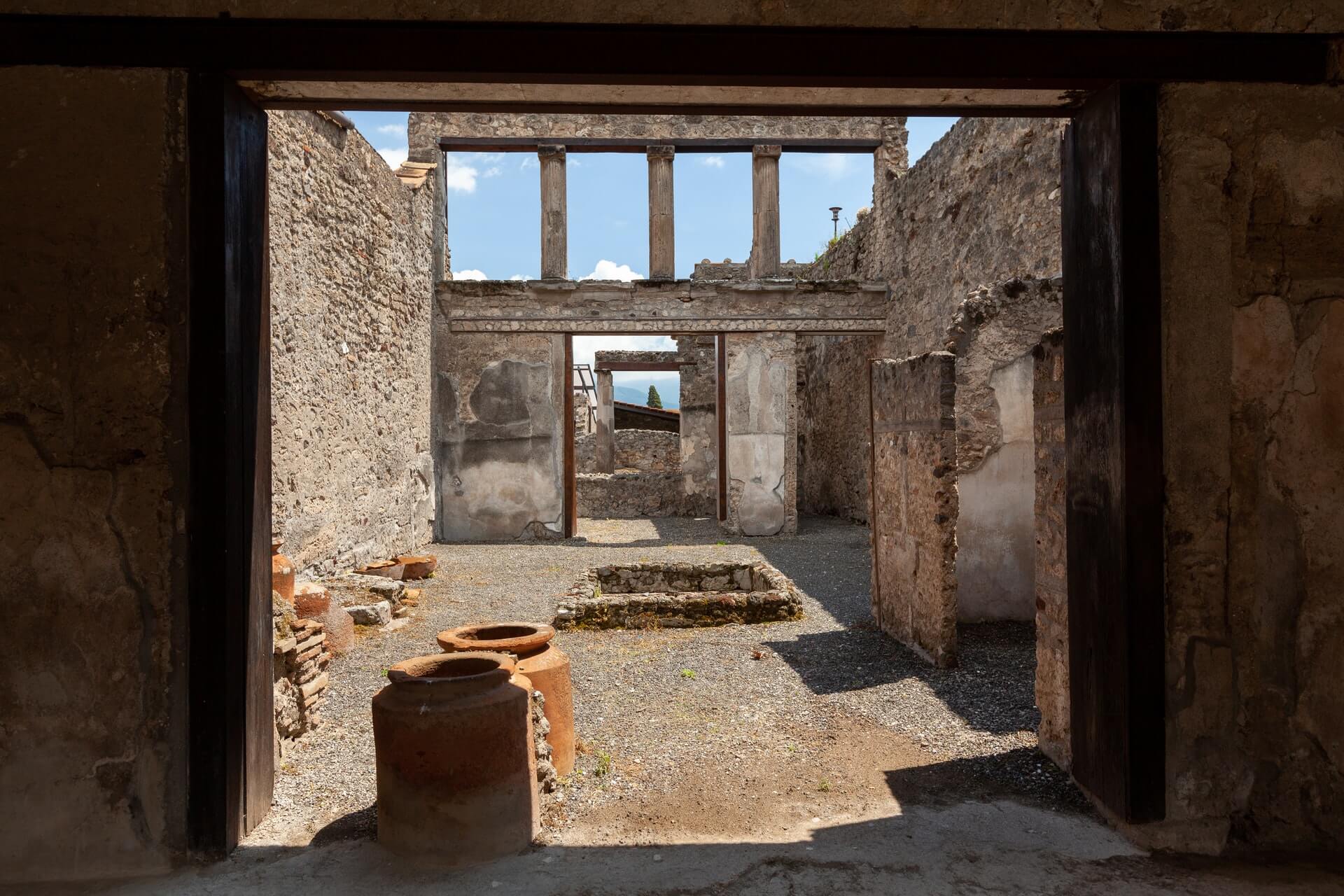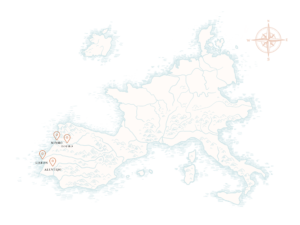
PORTUGUESE WINE IS THE RESULT OF TRADITIONS INTRODUCED TO THE REGION BY ANCIENT CIVILIZATIONS.
Portugal’s winemaking history goes back for several millennia. The Tartessians, a civilization who inhabited southern Portugal, mainly the Algarve and southern Alentejo region, as well as southwest Spain, are said to be the first who planted vines and made wine in the Sado and Tagus valleys around 2000 BC.
The Phoenicians would later arrive and take over the wine trade around the ninth century BC before the Carthaginians took possession of the Iberian Peninsula in 450 BC. All of these cultures had a wine making tradition and brought with them new grape varieties and techniques.
When the Romans began their expansion into Portugal around 200 BC, they modernized viticulture by introducing new varieties and enhancing certain cultivation techniques, particularly pruning. Wine was not only produced for local consumption, as well as for export to the Empire.

The decline of the Roman Empire and the rise in Christianity in the 6th and 7th centuries AD gave another push to grape cultivation in Portugal, as wine is an essential part in Christian worship. Between the 12th and 13th centuries, wine became the country’s main export.
The “Age of Discovery” only increased its value, as Portuguese explorers and traders brought the product to the four corners of the world.
Port, a sweet red wine commonly enjoyed as a dessert, was particularly sought after, especially by the British. The spirit is Portugal’s best-known wine and features hints of raspberry, blackberry, caramel, cinnamon and chocolate. “Quintas” (wineries) that practice traditional methods will ferment Port in lagars, where people stomp grapes with their feet.
Port is produced in the Douro region, which in 1756 was designated by Marquis de Pombal as one of the first wine-producing regions in the world in an effort to create a standard of quality for the beverage. The Douro Valley Wine Region and Pico Island Wine Region are now two Portugal wine regions protected by UNESCO as World Heritage.
But those are not the only wine producing regions in Portugal, ranked 9th in the world among top wine exporting countries.
DEMARCATED WINE REGIONS IN PORTUGAL AND ITS CASTAS
VINHOS VERDES
Portugal’s wine was originally classified into Vinho Verde (literal, green wine, but also translated as young wine) and Vihno Maduro. Vinhos Verdes, which may be red, white, or rosé stem from the Minho province in northern Portugal. Vinhos Verdes are light, fresh, and citrusy with high natural acidity. Their flavor notes include lemonade, white melon, gooseberry, grapefruit and lime blossom.
White castas: Alvarinho, Arinto (Pedernã), Avesso, Azal, Batoca, Loureiro, Trajadura;
Red castas: Amaral, Borraçal, Alvarelhão, Espadeiro, Padeiro, Pedral, Rabo de Anho, Vinhão.
PORTO / DOURO
Port hails from the Douro Valley of northern Portugal, a region flanked by the Marão and Montemuro mountains with hot and dry summers and cold winters.
The world-famous Portuguese dessert wine came to be as the British added brandy to still red wines as they transported the product on long voyages back to England. Brandy is still added during the fermentation process, leaving a semi-sweet taste profile. Port styles include ruby, with hints of blackberry, plums, and dates; tawny, which carries cherry, smoky vanilla, nutty, and caramelized notes; white, with raisin, spice, honey and citrus influences; and rosé, with notes of grapefruit, berries and honey.
Red castas: Touriga Nacional, Tinta Amarela, Aragonez, Bastardo, Castelão, Cornifesto, Donzelinho Tinto, Malvasia Preta, Marufo, Rufete, Tinta Barroca Tinta Francisca, Tinto Cão, Touriga Franca;
White castas: Arinto, Cercial, Donzelinho branco, Folgazão, Gouveio, Malvasia Fina, Moscatel Galego branco, Rabigato, Samarrinho, Semillon, Sercial, Roupeiro, Verdelho, Viosinho, Vital.
DÃO
This is one of the higher regions of Portugal, along the Serra da Estrela, Serra do Caramulo, and Serra da Nave mountain ranges in the north central part of the country. Wine cultivation here is at high altitudes, ranging from 600 to 3300 feet. Winters in the area are rainy, keeping the granite soil hydrated year-round. Nights are cool and days war, slowing the ripening process and creating wines with strong aromas an acidity.
Red castas: Touriga Nacional, Alfrocheiro, Aragonez, Jaen e Rufete;
White castas: Encruzado, Bical, Cercial, Malvasia Fina, Verdelho.
BAIRRADA
Once the site of battles between Christians and Arabs over control of the Portuguese Empire, Bairrada rests along the Atlantic Ocean and has a cool, damp, maritime climate. The region takes its name from the constant rains and the predominantly clay (barro) soil there. Such locale gives birth to sparkling wines with high acidity and hints of blackberry fruit and floral flavors.
Red castas: Baga, Alfrocheiro, Camarate, Castelão, Jaen, Touriga Nacional, Aragonez;
White castas: Maria Gomes, Arinto, Bical, Cercial, Rabo de Ovelha, Verdelho.
BUCELAS
Located just north of Portugal’s capital, Lisbon, the Bucelas wine region stretches between the Serra Montejunto and the Tejo river. Cool air from the Atlantic reaches the area, providing a dry, cool climate protected from the fog by the nearby hills. Wines from this area have a light, fruity taste with hints of lemon, apple, and sometimes tropical notes with high acidity.
White castas: Arinto, Sercial e Rabo de Ovelha.
COLARES
The smallest wine region in Portugal is located along the central Atlantic coast, where vines grow literally a stone throw from the ocean. Yet, they are protected from the strong ocean winds by sandy dunes. The sandy soil also protects the vines from the phylloxera plague that nearly wiped out European vineyards in the late 19th century. Phylloxero aphids cannot live on sand. Red wines from this region tend to carry the aroma of violets and have dark fruit flavors with a saline character (due to its proximity to the ocean) with pronounced acidity and tannins. White wines offer a blend of jasmine and tropical fruit hints with flavor characters of lemon, peach, apricot, and honey.
Red casta: Ramisco;
White casta: Malvasia
CARCAVELOS
Lying just west of Lisbon, this wine region has reduced in size over the last decades amid the capital’s urban expansion. It is exposed to the Atlantic coast on three sides and enjoys a Mediterranean climate. Wine from the region enjoyed high demand among the English nobility in the early 19th century when Napoleon Bonaparte invaded Portugal and cut off port supplies. Red wines from the region are marked by colors that go from ruby to topaz with a velvety character, nutty aroma and flavors. White wines have yellowish to golden hues with fruity flavors.
Red castas: Castelão and Preto Martinho;
White castas: Galego Dourado, Ratinho, Arinto.
SETÚBAL
Believed to be the birthplace of the Portuguese wine tradition, where the first grape vines were planted some 4000 years ago, Setúbal lies in the southern tip of the Iberian Peninsula, marked by warm maritime climate. Grapes grow on flat lands with sandy soils and wine from the area gained international fame when English king Richard II ordered Moscatel de Setúbal for the royal court in the 14th century. Moscatel de Setúbal is infused with flavors of orange and raisins, and nutty aromas. Red Moscatel is noted for its purple-pink hue, rich and intense aroma of wild and red berries, and hints of orange tree, roses and dry fruits in its flavor.
Red casta:Moscatel Roxo;
White casta: Moscatel de Setúbal.
ALENTEJO
Known for its cork production due to the proliferation of oaks, the Alentejo wine region is one of the largest in land mass, stretching from the Spanish border to the east and the Algarve region to the south. Located in the south-central part of Portugal, it features a variety of plains and mountains, with soil of different ranges and temperatures that swing from heat in the summer to frost in the winter. Red wines have a strong fruit and mocha hints. White wines carry tropical fruit flavors.
Red castas: Alfrocheiro, Aragonez, Periquita1, Tinta Caiada, Trincadeira, Alicante Bouschet, Moreto;
White castas: Antão Vaz, Arinto, Fernão Pires, Rabo de Ovelha, Roupeiro.
ALGARVE
The name derives from the Arabic Al-Gharb (meaning ‘of the west’) Andalus in reference to the area in Spain controlled by the invading Moors during the Middle Ages. Algarve is situated amid a chain of mountains running from the Spanish border to the Atlantic coast. The region enjoys dry, Mediterranean climate and the soil varies from sandy, clay, limestone and sandstone. The area is a tourism paradise, renowned for its beautiful, sun-splashed beaches and golf courses. The red wines in this region have low acidity and highly aromatic. They are characterized by hints of very ripe fruit. White wines are fresh, perfect for warm weather.
Red castas: Negra Mole, Trincadeira, Alicante Bouschet, Aragonez, Periquita;
White castas: Arinto, Roupeiro, Manteúdo, Moscatel Graúdo, Perrum, Rabo de Ovelha.
MADEIRA
The Portuguese were great explorers during the time of discovery, circumventing the globe in search of new trade routes to the Indies and America. Madeira, an island about 400 miles off the African coast of Morocco, with prominent mountain terraces, steep cliffs, and mild temperatures, was a usual stop on those long voyages. In order for the wine to survive the long stretches and not spoiled, it was fortified with other spirits—usually brandy. Thus was born Madeira wine, which can last hundreds of years in unopened bottles and has a distinct production method where it is heated repeatedly, leaving the beverage with prominent flavors of roasted nuts, caramel, and toffee, and a certain salinity due to its location in the middle of the ocean. Some 85% of the red wine is made with Tinta Negra grapes, which infuses it with a blend of citrus and walnut flavors. Malvasia grapes give life to a majority of the white wines, which carry sweet and spicy notes with hints of toffee and red pepper.
Red castas: Bastardo, Tinta, Malvasia Cândida Roxa, Verdelho Tinto e Tinta Negra;
White castas: Sercial, Malvasia Fina (Boal), Malvasia Cândida, Folgasão (Terrantez), Verdelho.
TEJO
One of the oldest wine producing region in Portugal, viticulture in Tejo goes back to the first vines panted during Roman Times. Similarly, wine making traditions are still practiced by many of the quintas, where locals still foot-trod grapes in open granite lagares, and the grape harvest is a communal activity with festivals and traditional songs. Located in the central area of the country, just a short drive from the capital, Lisbon, the region is marked by flatlands along the Tejo river, the longest in the country at 645 miles. Known previously as Ribatejo, the area is mostly pastoral and enjoys a warm, dry climate. Red wines from Tejo tend to be aromatic with a deep red hue, fruity hints and smooth tannins. White wines are zesty and vivacious, with high acidity levels and floral, tropical notes.
Red castas: Baga, Camarate, Castelão, Trincadeira, Tinta-Miúda, Preto-Martinho, Aragonez, Touriga-Franca, Touriga-Nacional, Alfrocheiro, Caladoc, Esgana-Cão-Tinto, Jaen, Petit Verdot, Tinta-Barroca, Tinta-Caiada, Tinto-Cão, Merlot, Cabernet-Sauvignon, Bastardo, Pinot noir, Alicante-Bouschet, Grand noir, Moreto, Syrah;
White castas: Arinto, Fernão Pires, Rabo-de-Ovelha, Tália, Trincadeira-das-Pratas, Vital, Verdelho, Tamarez, Cerceal branco, Alicante branco, Chardonnay, Malvasia-Rei, Pinot blanc, Sauvignon, Alvarinho, Moscatel-Graúdo, Síria, Viosinho.

birdie deQuay


Post a Comment